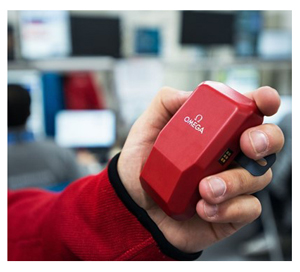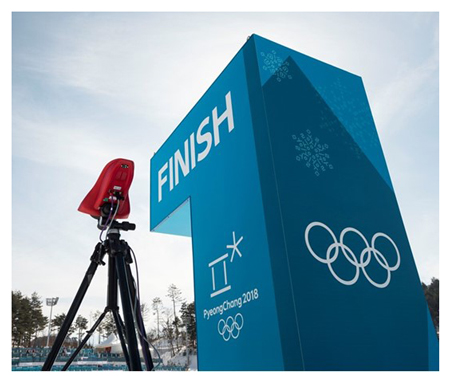New technologies at PyeongChang Winter Olympics
As the PyeongChang Winter Olympics kicks off this year, paving the way for a dynamic Olympic Games future is OMEGA. With its incredible sensor systems, the brand will now provide continuous measurements from start to finish of events, meaning that athletes can gain an immediate understanding of where they gained or lost time, or where they won or lost points.
From the live speed of a single alpine skier - to the formations of an entire ice hockey team – the information provided by OMEGA will add a brand new dimension to every performance.
"For the very first time Omega is going to deploy motion sensor technologies that are going to be placed in five different sports. Those technologies allow us to provide instant information of the performance of the athlete between the start and finish," said Alain Zobrist, CEO Omega Timekeeping.
Additionally, this information will mean that people in the venues, as well as those at home watching on television, can have a far greater understanding of each sport as it happens.
Everything in 2018 is about enhancing the viewer experience and providing live information that athletes can use to analyse their performances.
This is the first time at the Olympic Games that such in-depth data will be made instantly available and it is almost certainly the beginning of a brand new era.
This is what it means for each sport…
Alpine Skiing
Measurements can now include things such as acceleration and brake. But firstly, the athlete’s speed can be shown live as they start the run, and can constantly update at various intermediate points. Alongside this, the speed can also be compared to the fastest athlete at the same point.
At the end of the run, OMEGA can provide an in-depth run analysis that broadcasters can use to compare athletes with each other. The data can also be made available to athletes and their coaches for analysis. In addition to this, systems such as Stromotion and Simulcam will become invaluable for knowing exactly where a competitor won or lost time.
Cross Country and Nordic Combined
At PyeongChang, OMEGA's new Positioning System can track the live position of the athletes in both Cross Country and Nordic events. Information can be displayed for single competitors or groups and will be able to show distances to the finish, speed, and times between groups.
When a single athlete is shown on screen, it will also be possible for OMEGA’s system to compare their performance with the current leader. This can even be shown to include multiple intermediate points.
Finally, an innovative gradient chart will be available to pinpoint an athlete’s position on the course inclines and also compare them with others.
Ski Cross and Snowboard Cross
OMEGA has the capacity to measure many elements of these exciting events. In fact, almost any part of the run can be analysed in-depth. In the seeding and qualification rounds (when only one athlete is on the course), OMEGA will provide a cross jump analysis that can be viewed live or through replays.
 The information will begin with a ‘take off’ speed at each jump.
The information will begin with a ‘take off’ speed at each jump.
This will be followed by a distance measurement that updates live through the jump (showing in white), before a complete distance is given.
Finally, a landing speed will be indicated after each jump.
Speed Skating
A fast-paced sport at the heart of the Olympic Winter Games, speed skating is set to become even more enthralling for those watching. In individual events, except for Mass Start, live speeds can now be shown on screen and can update live as the speed changes.
In comparison to the current overall leader’s time, it is also possible to show live delta, giving viewers a unique understanding of how each competitor is progressing.
OMEGA can now also show live positioning of each athlete or team on the oval. By pinpointing these positions, it will be clear to see who is gaining an advantage.
A line to beat can also be shown live on the ice, indicating the distance that an athlete needs to make up to come first.
Short Track Speed Skating
After the finish of a race, it will be possible during the replay to show the distance between the skates of first and second placed athletes, or second and third. Taken from the finish line, it will add more precision to this fast-paced sport.
Bobsleigh
Sensors inside each bobsleigh will be able to measure various factors including G forces, angles, trajectory and acceleration that will enable teams to understand where they won or lost time on the track.
Primarily, as the team tears downhill, repeater antennas placed along the track will transmit the bob's live speed. On television, this data can be shown as a white line on a meter, with a green tip to indicate the highest speed achieved by the current sled.
Once the sled starts to decelerate, the best speed achieved can be displayed.
If the sled beats the current “top speed” of the competition at any point in the course, this can be indicated in red.
In bobsleigh, skeleton and luge, the Sled Path system provided by OMEGA can also help to compare the performances between different teams. The current sled will always be shown in red, while the path of the current leader will be shown in blue. With this method, it will be possible to see the different techniques of each team.
Freestyle and Snowboard – Half Pipe
Half pipe is action packed, with many criteria all taken into consideration when scoring. The display that viewers will see on screen can now include each competitor’s highest jump as well as their average jump height. This information will be shown after each run has finished. The system can even capture the number of rotations in a certain jump.
Ice Hockey
In-depth information can be valuable to teams, who will be able to use it after a game to analyse their performance.
Connected to the main motion sensor data, OMEGA's ice hockey analytical tool will also provide an exciting visual representation of what just happened on the ice. During replays and game analysis, it can highlight players and the puck, track athlete and puck movement, show the speed of individual athletes, show time on ice, measure distances between players and display team formations.
Ski Jumping / Nordic Combined
When jumping from great heights, everything has to come together perfectly for the competitor. At PyeongChang 2018, OMEGA will be able to provide valuable competition-relevant data for athletes and will allow spectators to zone right in on the finest details.
‘In-run’ speed will be one of the primary factors that might interest viewers, and this can now be displayed for each jump.
Then, as they hit the jump, the display can change to show the ‘take-off’ speed measurement.
‘At 20m’ of their jump, a mid-air speed can be shown, while also highlighting how much faster, similar or slower it is compared to their ‘take-off’ speed.
Finally, a ‘landing speed’ will be instantly calculated and displayed. These measurements will all disappear seconds later, or when the distance measurement becomes available.
A virtual line will also be displayed across the landing zone during live coverage to show the current distance to beat.
Stromotion
In South Korea, OMEGA will be using its new ‘Stromotion’ technology to break down the action into sections and take a closer look. Trajectory video footage will now neatly reveal the evolution of an athlete's movement or technique to show you exactly how good it was.
Other events in which stromotion will be used include alpine skiing, figure skating, aerial events and halfpipe.
Simulcam
OMEGA’s Simulcam will help to enhance the replay action of numerous events in PyeongChang. By laying an image of one competitor over another, it will be possible for replays to compare the techniques and performances of different teams.
Events in which you might see Simulcam used include alpine skiing, bobsleigh, skeleton, luge, ski jumping and Nordic combined.
Course Maps and Animations
To give viewers a clear idea of the courses and venue layouts, OMEGA can now provide course maps and animation, layered with virtual graphics and information










